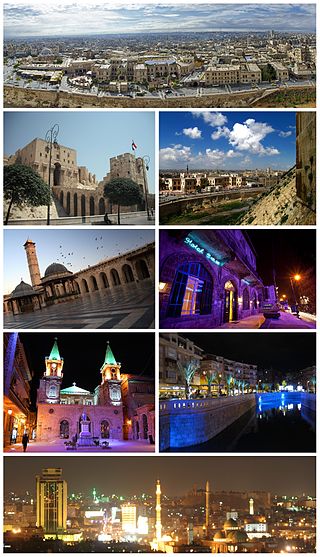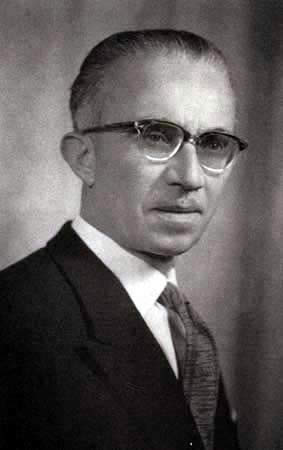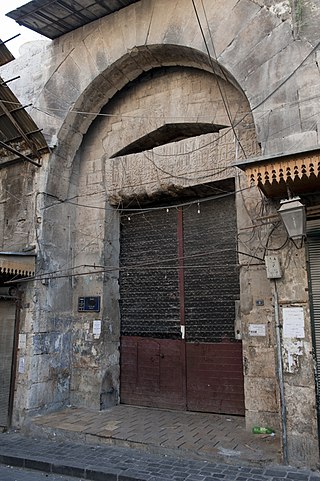Related Research Articles

Aleppo is a city in Syria, which serves as the capital of the Aleppo Governorate, the most populous governorate of Syria. With an estimated population of 2,098,000 residents as of 2021, it is Syria's second-largest city and also one of the largest cities in the Levant region.

Nazim al-Qudsi, was a Syrian politician who served as President of Syria from 14 December 1961 to 8 March 1963.

The Dead Cities or Forgotten Cities are a group of 700 abandoned settlements in northwest Syria between Aleppo and Idlib. Around 40 villages grouped in eight archaeological parks situated in north-western Syria provide an insight into rural life in Late Antiquity and during the Byzantine period. Most of the villages, which date from the 1st to 7th centuries, were abandoned between the 8th and 10th centuries. The settlements feature the well-preserved architectural remains of dwellings, pagan temples, churches, cisterns, bathhouses etc. Important dead cities include the Church of Saint Simeon Stylites, Serjilla and al Bara.
The 1138 Aleppo earthquake was among the deadliest earthquakes in history. Its name was taken from the city of Aleppo, in northern Syria, where the most casualties were sustained. The earthquake also caused damage and chaos to many other places in the area around Aleppo. The quake occurred on 11 October 1138 and was preceded by a smaller quake on the 10th. It is frequently listed as the third deadliest earthquake in history, following on from the Shensi and Tangshan earthquakes in China. However, the figure of 230,000 deaths reported by Ibn Taghribirdi in the fifteenth century is most likely based on a historical conflation of this earthquake with earthquakes in November 1137 on the Jazira plain and the large seismic event of 30 September 1139 in the Transcaucasian city of Ganja.
The Historic Cities Programme (HCP) of the Aga Khan Trust for Culture (AKTC) promotes the conservation and re-use of buildings and public spaces in historic cities of the Muslim world. HCP undertakes the restoration and rehabilitation of historic structures and public spaces in ways that can spur social, economic and cultural development. Individual projects go beyond technical restoration to address the questions of the social and environmental context, adaptive reuse, institutional sustainability and training. In several countries, local Aga Khan Cultural Service companies have been formed to implement projects under the supervision of the HCSP headquarters in Geneva.

The Citadel of Aleppo is a large medieval fortified palace in the centre of the old city of Aleppo, northern Syria. It is considered to be one of the oldest and largest castles in the world. Usage of the Citadel hill dates back at least to the middle of the 3rd millennium BC. Occupied by many civilizations over time – including the Armenians, Greeks, Byzantines, Ayyubids, Mamluks and Ottomans – the majority of the construction as it stands today is thought to originate from the Ayyubid period. An extensive conservation work took place in the 2000s by the Aga Khan Trust for Culture, in collaboration with Aleppo Archeological Society. Dominating the city, the Citadel is part of the Ancient City of Aleppo, an UNESCO World Heritage Site since 1986. During the 2010s, the Citadel received significant damage during the lengthy Battle of Aleppo. It was reopened to the public in early 2018 with repairs to damaged parts underway. The citadel was damaged by the 2023 Turkey–Syria earthquake.

The Citadel of Damascus is a large medieval fortified palace and citadel in Damascus, Syria. It is part of the Ancient City of Damascus, which was listed as a UNESCO World Heritage Site in 1979.

Bab al-Nasr meaning the Gate of Victory, is one of the nine historical gates of the Ancient City of Aleppo, Syria.

Alexis T. Belonio is a professor, engineer, scientist, innovator, and inventor from the Philippines. He was "the first Filipino to receive the Rolex Award for Enterprise" in 2008 for his invention of a low-cost and environment friendly rice husk stove. Belonio was included by the Rolex watchmaking company on its list of 10 model innovators in November 2008. He serves as the incumbent chair of the Agricultural Engineering and Environmental Management department of Central Philippine University.

Baron Hotel, is the oldest hotel that currently operates in Syria. It is located on Baron street in down-town Aleppo's Aziziyeh district. The Baron has sustained some civil war-related minor damage but is still standing.

Al-Shibani Church, also known as al-Shibani School, is a 12th-century religious and cultural centre located in al-Jalloum district of the Ancient City of Aleppo, Syria. The complex is located to the west of the al-Saffahiyah Mosque and of the south of Souq Khan al-Nahhaseen.

The Ancient City of Aleppo is the historic city centre of Aleppo, Syria. Before the Syrian Civil War, many districts of the ancient city remained essentially unchanged since its construction during the 12th to the 16th century. Being subjected to constant invasions and political instability, the inhabitants of the city were forced to build cell-like quarters and districts that were socially and economically independent. Each district was characterized by the religious and ethnic characteristics of its inhabitants.

Al-Hatab Square is one of the oldest squares in the Syrian city of Aleppo. It is located in the old Jdeydeh Quarter, outside the historic walls of the Ancient City of Aleppo. The square suffered catastrophic damage during the Syrian civil war.

Al-Jdayde is a historic predominantly Christian neighbourhood of Aleppo. It is noted for its winding narrow alleys, richly decorated mansions and churches. It was an area of significant cultural and historical interest. Much of Al-Jdayde suffered catastrophic damage during the Syrian Civil War.

Beit Ghazaleh is one of the largest and better-preserved palaces from the Ottoman period in Aleppo. It was named after the Ghazaleh family that owned it for about two centuries. Since 1914, it was used as a public school and was recently restored to host the Memory Museum of the city of Aleppo. Beit Ghazaleh is located in the Al-Jdayde district of Aleppo.

Although Syria has some of the oldest cities in Western Asia, such as Damascus and Aleppo, tourism in Syria has greatly reduced as a result of the Syrian War, that began in 2011 and is ongoing, and its associated refugee crisis. Tourism has been further impacted by the outbreak of COVID-19 starting in March 2020. The international economic sanctions imposed on Syria and the sharp drop in the value of the Syrian pound also adversely impact tourism in Syria. The Ministry of Tourism is the responsible government department.

Beit Achiqbash ; is an old Aleppine courtyard mansion built in the mid 18th Century by Qarah Ali (Karaly), a wealthy Christian merchant.
References
- ↑ "Syria's second city Aleppo enjoys renaissance". Reuters. 20 March 2007. Retrieved 2018-03-21.
- ↑ "Anthony Sattin - The End of the Silk Road". Literary Review. Retrieved 2018-03-21.
- ↑ "Phil Dickie - The Secret of Keeping Ancient Cities Alive | Rolex Awards Blog". blog.rolexawards.com. Retrieved 2018-04-09.
- 1 2 3 "Adli's labour of love". The Daily Star Newspaper - Lebanon. 1998-10-23. Retrieved 2018-03-21.
- 1 2 Writer, Suchitra Bajpai Chaudhary, Staff (2007-09-13). "A true cityzen". GulfNews. Archived from the original on 2018-03-21. Retrieved 2018-03-21.
- ↑ The Forum on Cultural Heritage in a Developing World (Oct 19, 2010. . Publisher: Stanford University, Stanford Institute for Economic Policy Research
- ↑ Renahan, Anne (Oct 23, 1998). . Publisher: Daily Star Lebanon.
- 1 2 3 "Tribute to Adli Qudsi, Associate Laureate 1998 | Rolex Awards Blog". blog.rolexawards.com. Retrieved 2018-03-21.
- ↑ "Aleppo's Old Town: World Cultural Heritage Threatened by Syria's Civil War - Qantara.de". Qantara.de - Dialogue with the Islamic World. Retrieved 2018-03-21.
- ↑ "A stitch in time. - Free Online Library". www.thefreelibrary.com. Retrieved 2018-03-21.
- ↑ The Forum on Cultural Heritage in a Developing World (Oct 19, 2010).. Publisher: Stanford University, Stanford Institute for Economic Policy Research
- ↑ "Rolex Awards for Enterprise". Rolex Awards for Enterprise : Adli Qudsi : Overview. Retrieved 2018-03-21.
- ↑ Qudsi, Jwanah (2017-07-07). "Perspective | The battle for Aleppo is over. I returned to my hometown to see what's left". Washington Post. ISSN 0190-8286 . Retrieved 2018-03-21.